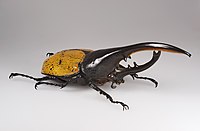
Photo from wikipedia
Abstract Arc magmas are very distinct in their geochemical signatures, a consequence of trace element enriched components from the subducting slab that are incorporated into melts of the overlying mantle… Click to show full abstract
Abstract Arc magmas are very distinct in their geochemical signatures, a consequence of trace element enriched components from the subducting slab that are incorporated into melts of the overlying mantle wedge. However, it is not always straightforward to distinguish such slab components from assimilation of crustal rocks during subsequent differentiation, given that both reservoirs can share similar geochemical characteristics. This has prompted the development of new tools, such as 98Mo/95Mo analyses used in combination with Ce/Mo measurements. The diverse range of δ98/95Mo in the surface environment gives rise to variable isotopic compositions of subducted Mo. Most diagnostic of these is the extremely isotopically heavy Mo in marine black shales, such as those drilled in the vicinity of the Lesser Antilles. However, subducting assemblages are invariably complex and differing melting behaviours and contrasting δ98/95Mo of various crustal components may counter-balance one another, requiring a more detailed investigation of the behaviour of Mo and Ce in the down-going slab. This study is dedicated to identifying possible hosts for Mo and Ce in sediments and basalt at sub-arc depths. New melting experiments were performed (3 GPa, 800–900 °C), using synthetic carbon-rich black shale and calcareous sediment compositions from the Lesser Antilles arc. In addition, new analyses of Mo concentrations and Ce/Mo data of previously published partial melting studies on altered oceanic crust and volcaniclastics (Mariana Arc) are presented. Our study suggests that sulfide and to a lesser extent rutile are the major hosts for Mo in eclogites, whereas the presence or absence of monazite (Ca-poor sediments), epidote (Ca-rich sediments) and carbonate (CaCO3-rich sediments) controls Ce concentrations in sediments. Redox conditions are found to be of great importance for the Ce/Mo ratios of slab components derived from these lithologies because of their influence on sulfide and epidote stability. It is further shown that rutile only hosts Mo at suitably reducing conditions, in concordance with previous studies. The combination of measured Ce/Mo with our experimental results thus places important constrains on phase petrology and redox conditions in the subducted slab.
Journal Title: Geochimica et Cosmochimica Acta
Year Published: 2017
Link to full text (if available)
Share on Social Media: Sign Up to like & get
recommendations!